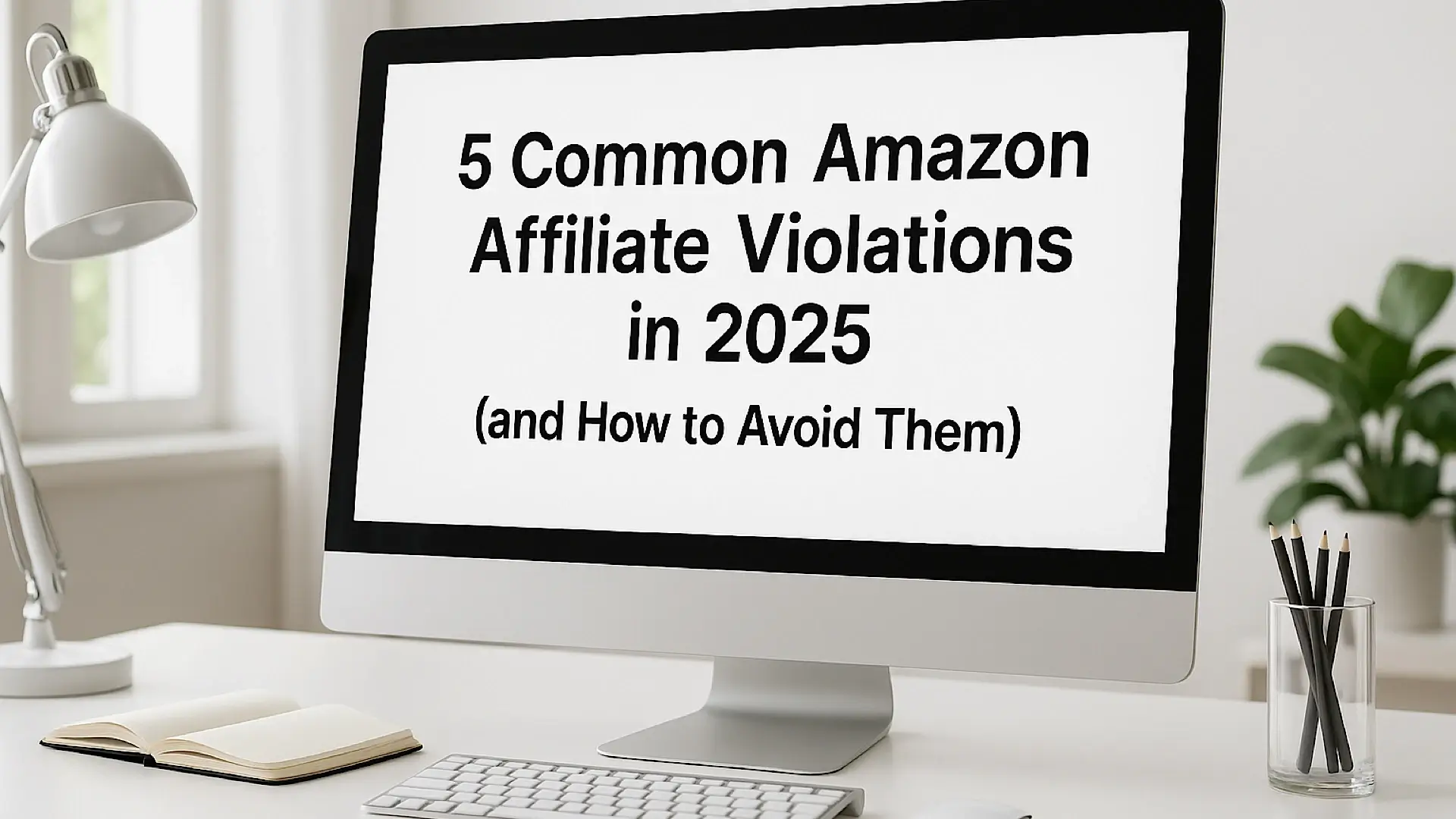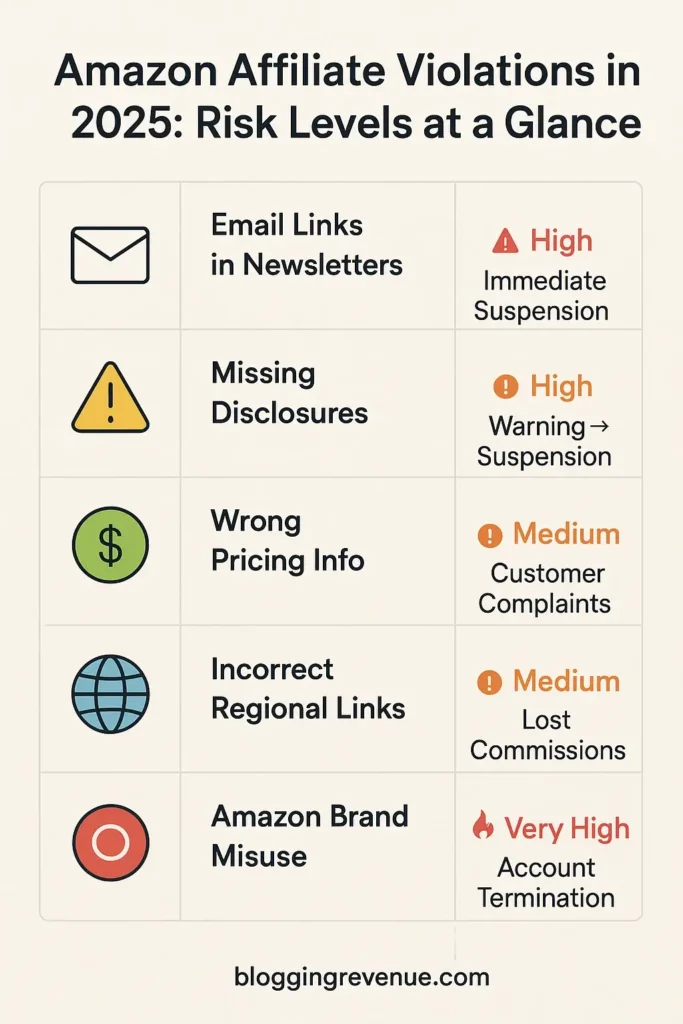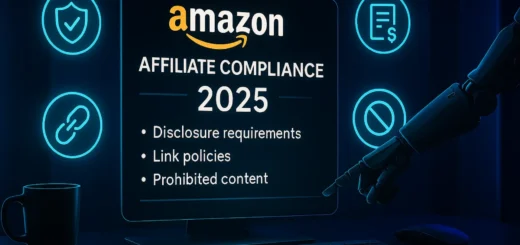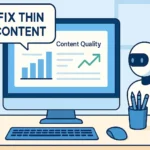5 Common Amazon Affiliate Violations in 2025 (and How to Avoid Them)

Introduction
Amazon affiliate violations 2025 are stricter than ever, and failing to comply could result in lost income, account bans, and long-term damage to your business. Recent industry data shows that 37% of affiliate accounts were deactivated in 2024 due to policy violations, with many marketers losing thousands of dollars in commissions overnight.
The stakes have never been higher. Amazon’s automated systems now scan millions of affiliate sites daily, flagging violations that previously went unnoticed. What once seemed like minor oversights can now result in immediate account suspension and forfeiture of earned commissions.
Understanding these violations isn’t just about compliance—it’s about protecting your income stream and building a sustainable affiliate business. If you’re brand-new, start with our complete beginner’s guide to starting a blog and making money in 2025. Let’s explore the 5 most common Amazon Affiliate Violations in 2025 and how to stay compliant.
1. Using Amazon Affiliate Links in Emails or PDFs
One of the most frequent violations occurs when marketers include Amazon affiliate links directly in emails, PDFs, or other non-public formats. Amazon’s Operating Agreement explicitly states that affiliate links can only be used on publicly accessible websites.
The Risk
Many marketers unknowingly violate this rule by:
- Sending newsletters with direct Amazon links
- Including affiliate links in downloadable PDFs
- Sharing links in private Facebook groups
- Using affiliate links in email courses
Real Example: A fitness blogger lost their account after including Amazon supplement links in their weekly newsletter, despite having a successful blog with proper disclosures.
How to Avoid This Violation
The solution is simple: always use bridge pages. Instead of linking directly to Amazon products in emails, direct subscribers to a blog post or landing page that contains your affiliate links.
Best Practice Strategy:
- Create dedicated review posts for products
- Link to these posts in your emails
- Include affiliate links within the blog content
- Use compelling call-to-actions to drive clicks
This approach not only keeps you compliant but also provides more value to your audience with detailed product information and comparisons. For even higher engagement, see how we boosted email open rates by 37 percent.
2. Not Disclosing Affiliate Relationships Properly
The Federal Trade Commission (FTC) requires clear disclosure of affiliate relationships, and Amazon enforces this strictly. Missing or inadequate disclosures are responsible for approximately 23% of all account suspensions in 2025.
Common Disclosure Mistakes
- Using vague language like “I may earn a commission”
- Placing disclosures in footers where they’re easily missed
- Using tiny fonts or colors that blend with the background
- Forgetting disclosures on social media posts
The Compliant Solution
Required Disclosure Text: “As an Amazon Associate, I earn from qualifying purchases.”
Best Placement Practices:
- Top of blog posts: Most visible location
- Before affiliate links: Clear connection between disclosure and links
- Social media: Include #ad or #affiliate hashtags
- Video content: Verbal disclosure in first 30 seconds
Automation Tools
Popular WordPress plugins that automate disclosures (and, before you commit, compare e-mail platforms in our ConvertKit vs Mailchimp guide for bloggers 2025):
- Rank Math SEO: Automatically adds disclosures to posts
- AAWP (Amazon Affiliate WordPress Plugin): Built-in compliance features
- Lasso: Comprehensive affiliate link management with auto-disclosures
Many beginner marketers overlook small compliance gaps that later turn into serious Amazon Affiliate Violations 2025, leading to unnecessary account risk.
3. Displaying Incorrect Product Pricing or Availability
Amazon’s pricing changes constantly—sometimes multiple times per day. Displaying outdated prices or availability information violates their terms and misleads customers.
The Problem
Manual price updates are nearly impossible to maintain and often lead to unintended Amazon Affiliate Violations 2025, especially on larger content sites:
- Prices can change dozens of times daily
- Out-of-stock items may restock without notice
- Sale prices expire automatically
- Different regions have different pricing
Compliance Solutions
| Method | Accuracy | Effort Required | Cost |
|---|---|---|---|
| Manual Updates | Low | Very High | Free |
| Amazon API | High | Medium | $0–50/month |
| AAWP Plugin | High | Low | $59–199/year |
| Lasso Plugin | High | Low | $59–299/year |
Recommended Approach:
- Use Amazon’s Product Advertising API for real-time data
- Add timestamp disclaimers: “Price last updated: [DATE]”
- Implement automatic updates every 24 hours minimum
- Use established plugins like AAWP or Lasso for reliability—our ultimate guide to Amazon affiliate site tools walks you through the setup.
Pro Tip for Pricing Displays
Instead of showing exact prices, use ranges or general terms:
- “Starting at $X” instead of specific prices
- “Check current price on Amazon” with direct links
- Price comparison tables with “last updated” timestamps
4. Linking to Products Outside Your Approved Regions
Geographic restrictions are often overlooked but are a common cause of Amazon Affiliate Violations 2025, leading to lost commissions and policy strikes.. Amazon Associates accounts are region-specific, and cross-border linking without proper setup violates terms.
Common Regional Mistakes
- UK affiliate linking to Amazon.com products
- Canadian marketers using US affiliate links
- European affiliates mixing different country domains
- Not optimizing for international traffic
The International Solution
OneLink Technology: Amazon’s official solution for international affiliates
Setup Process:
- Join Amazon Associates in your primary country
- Apply for additional international programs
- Implement OneLink code on your website
- Configure geographic redirects
Alternative Solutions
| Tool | Best For | Pricing | Key Features |
|---|---|---|---|
| OneLink | Official Amazon solution | Free | Automatic redirects, commission tracking |
| Geniuslink | Advanced analytics | $9–49/month | Detailed reporting, multiple networks |
| Lasso | WordPress users | $59–299/year | Built-in international linking |
International Traffic Optimization:
- Use geo-targeted content for different regions
- Create separate landing pages for major markets
- Monitor traffic sources and optimize for top countries
- Test conversion rates across different Amazon domains; for a step-by-step blueprint see Mastering Amazon Affiliate Niche Sites (2025 Edition).
5. Using Amazon Brand Assets Without Permission
Unauthorized use of Amazon’s logos, product images, or brand materials is considered a major Amazon Affiliate Violations 2025 issue under Amazon’s Trademark Guidelines and may result in immediate account termination. If you rely on Pinterest traffic, be sure to review our Pinterest Pin Design Mastery guide for compliant visual strategies.
Prohibited Uses
- Downloading and hosting Amazon product images
- Modifying Amazon logos or branding
- Using Amazon’s copyrighted content in ads
- Creating misleading brand associations
Compliant Image Usage
Approved Methods:
- Amazon API images: Use direct links to Amazon-hosted images
- Plugin integration: Tools like AAWP automatically use compliant images
- Your own product photos: Take original photos of products you own
- Stock images: Use generic product category images
Image Compliance Checklist
✅ Use Amazon API for product images ✅ Link directly to Amazon-hosted images (don’t download) ✅ Take original photos when possible ✅ Avoid modifying Amazon branding ✅ Use proper attribution when required
Technical Implementation:
<!-- Compliant: Direct link to Amazon image -->
<img src="https://images-na.ssl-images-amazon.com/images/I/..." alt="Product Name">
<!-- Non-compliant: Downloaded and hosted locally -->
<img src="/uploads/amazon-product.jpg" alt="Product Name">
Amazon Affiliate Violations 2025: Risk Level Comparison
For a more detailed breakdown of each rule and how to stay safe, check out our Amazon Affiliate Compliance Guide for 2025.
Here’s a quick visual summary of how each type of Amazon Affiliate Violations 2025 is detected, ranked by severity:

| Violation Type | Risk Level | Detection Method | Typical Penalty |
|---|---|---|---|
| Email Links | High | Automated scanning | Immediate suspension |
| Missing Disclosures | High | FTC complaints | Warning → Suspension |
| Wrong Pricing | Medium | Customer complaints | Warning first |
| Regional Issues | Medium | Commission tracking | Lost commissions |
| Brand Asset Misuse | Very High | DMCA reports | Immediate termination |
Expert Insights: Industry Leader Perspectives
These expert observations reflect the growing importance of full compliance with Amazon Affiliate Violations 2025 regulations in today’s affiliate environment.
Industry leaders agree that staying compliant with Amazon Affiliate Violations 2025 standards is crucial for long-term success.
Pat Flynn (Smart Passive Income) emphasizes the importance of treating Amazon compliance as a long-term business investment: “The affiliates who survive Amazon’s strict enforcement are those who prioritize compliance from day one, not as an afterthought.”
Michelle Peterson (Making Sense of Cents) reports that proper disclosure practices have actually increased her conversion rates: “When readers trust your transparency, they’re more likely to purchase through your links.”
Spencer Haws (Niche Pursuits) notes that 2025’s enforcement changes have eliminated many low-quality affiliate sites: “The marketers who focus on compliance and user experience are seeing less competition and higher earnings.”
According to a recent study by Affiliate Marketing Hub, compliant affiliate sites report 34% higher long-term earnings compared to those that cut corners on compliance.
Account Protection Checklist
Use this monthly checklist to stay compliant with Amazon Affiliate Violations 2025 and protect your account; when you’re done, apply these 15 proven CRO tweaks to squeeze more revenue:
Technical Compliance
- [ ] All affiliate links use proper Amazon domains
- [ ] Disclosures are visible and correctly worded
- [ ] Product pricing updates automatically
- [ ] Images load from Amazon servers
- [ ] International links redirect properly
Content Compliance
- [ ] Email campaigns link to blog posts, not direct Amazon links
- [ ] Social media posts include proper hashtags
- [ ] Video content includes verbal disclosures
- [ ] PDF downloads contain no affiliate links
- [ ] All reviews follow Amazon’s guidelines
Monitoring Tasks
- [ ] Check for broken affiliate links
- [ ] Verify disclosure visibility on mobile devices
- [ ] Monitor commission tracking across regions
- [ ] Review recent Amazon policy updates
- [ ] Audit competitor compliance practices
Frequently Asked Questions About Amazon Affiliate Violations 2025
Can Amazon ban you without warning?
Yes, Amazon can and does suspend accounts without prior warning, especially for serious violations like unauthorized email marketing or brand asset misuse. Their automated systems flag violations immediately, and appeals are often unsuccessful. The best protection is proactive compliance.
Is it safe to use affiliate links on social media?
Social media affiliate links are allowed but require proper disclosure. Always include #ad or #affiliate hashtags, and ensure your disclosure is visible before users click your links. Instagram Stories and short-form content require especially clear disclosures due to space limitations.
How often should I update my product information?
Amazon’s terms require current pricing and availability information. Use automated tools that update at least daily, or add timestamps showing when information was last verified. Manual updates are insufficient for high-volume affiliate sites.
Can Amazon reclaim previous commissions after account closure?
Yes, Amazon can reclaim unpaid commissions if your account is terminated for violations. They may also recover payments made within the previous 60 days if violations are discovered. This makes compliance even more critical for high-earning affiliates.
How can I restore a deactivated account?
Account restoration is extremely difficult and rarely successful. Amazon typically requires proof that all violations have been corrected and may request a detailed compliance plan. Prevention through proper compliance is far more effective than attempting restoration.
What happens if I accidentally violate a rule?
Minor violations often result in warnings, but repeated or serious Amazon Affiliate Violations 2025 can lead to immediate account suspension. Document every compliance effort thoroughly and respond quickly to any communication from Amazon. Certain violations—such as unauthorized brand asset use—can trigger termination without warning, regardless of intent. These answers are based on the latest policy updates and are designed to help you avoid Amazon Affiliate Violations 2025 and build a sustainable affiliate business. For list-building monetization ideas, read The Ultimate Guide to Monetizing Your Email List in 2025.
Staying on top of Amazon Affiliate Violations 2025 can feel overwhelming, but consistent effort leads to long-term stability and trust with both Amazon and your audience.
Conclusion
Avoiding these 5 Amazon Affiliate Violations 2025 will protect your account and significantly increase your long-term earnings potential. While the affiliate landscape is becoming more challenging, those who stay fully compliant with Amazon Affiliate Violations 2025 standards are seeing reduced competition and stronger revenue growth as weaker sites are removed.
Remember that compliance isn’t just about following rules—it’s about building a sustainable business that serves your audience effectively. The extra effort invested in proper compliance pays dividends through account longevity and increased trust.
Ready to scale your affiliate marketing success? First, explore how to scale a blog to six figures in 2025, then join our Telegram channel “BloggingRevenue” for exclusive compliance updates, including tips to avoid Amazon Affiliate Violations 2025, advanced strategies, and real-time industry insights. Plus, check out our comprehensive Amazon Affiliate Compliance Guide for detailed implementation steps and compliance templates.
Your affiliate marketing success depends on staying ahead of these compliance challenges. Start implementing these strategies today to protect your income and build a thriving, sustainable affiliate business in 2025 and beyond.








